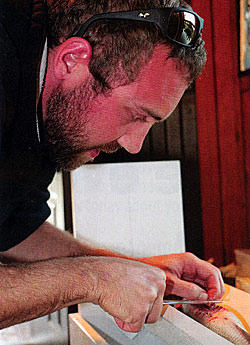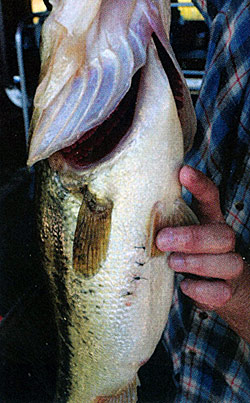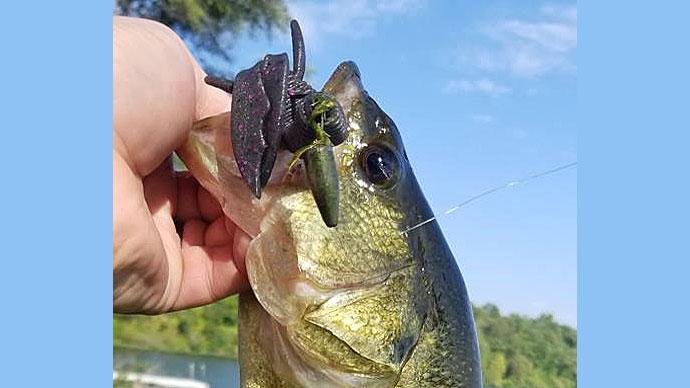
The world is always looking for the next new ground breaking idea. In the pond world one next new thing is telemetry, or more correctly, microtransmitter biotelemetry. In commonly used language, telemetry starts by placing tiny radio transmitters in fish to track and measure different aspects of their lives. This technology has been around a while (used in large water bodies by government entities), but has now become micro-sized, accurate, and more economical so that its use in smaller fisheries projects is becoming more common. The use of most technology, for example computers, cell phones, and the Internet, starts slow and momentum builds over time. Like those technologies, telemetry's use is,reaching critical mass for information collection in fisheries.
One new study using telemetry is Using Radiotelemetry to Compare the Initial Behavior and Mortality of Hatchery-Reared and Wild Juvenile Florida Bass, by Brandon C. Thompson, Wesley F. Porak, Erin H. Leone & Micheal S. Allen in Transactions of the American Fisheries Society, 145:2, 374-385, DOI: 10.1080/00028487.2015.1131739 (2016). This study answers some often-asked questions about the survival of newly stocked largemouth bass, both wild and hatchery feed trained, including their survival, growth, and movements. It also provides a glimpse of what is to come from this technology, and it is fascinating.
This study answered the obvious questions on survival, movement, and growth for small (3.5 - 4.7 inch) wild and pellet trained hatchery largemouth bass, tagged and stocked in an existing fishery with adult fish present. The purpose of the study was to answer the commonly asked questions raised by scientists engaged in supplemental stocking of lakes.

This several-week long study in each of two years revealed differences between tagged hatchery and wild Florida Bass indicating higher predation risk to the hatchery fish. Hatchery fish had greater dispersal, higher daily rates of movement, preference for open-water habitats, higher mortality, and slower growth than wild fish. A hatchery fish's initial unawareness of predators and lack of feeding efficiency probably increased risky behavior which resulted in higher mortality. The results showed a high rate of empty stomachs in the pellet-reared hatchery bass within the first 7 days after stocking, but diets became similar to wild fish at 14-60 days.
Based on this and information, we know exposing hatchery fish to live forage in hatchery ponds for two weeks prior to placement in wild environments can help with predator recognition and foraging methods. Further, we know that acclimating (habituation) of hatchery- reared juvenile fish before their release can improve post-stocking survival.
The real gems, in my opinion, are the facts that the use of telemetry provided. Some are set out below for your amazement. They include data only available through this technology. Read them slowly and let the data sink in.
All mortality for both years occurred within 14 days of release. In both years, high losses of hatchery fish were observed during the first 7 days after stocking. High mortalities for hatchery fish occurred in the first week, totaling 88% in Year 1 and 65% in Year 2. In Year 2, hatchery fish had 47% mortality and wild fish had 10% mortality. Post-stocking survival of hatchery fish, depending on assumptions used, ranged from 48% to 84% at 14 days in Year 1 and from 33% to 53% over the same period in Year 2.
Predation by fish and birds was determined to be the primary cause of mortality for hatchery fish, but predation was not observed on any wild bass. Predation was high in the first week after release, similar to other studies finding high mortality in the first days after stocking absent habituation. In Year 2, 36% of the total mortality was caused by fish predators while birds were responsible for at least 10%. The estimate of bird predation was judged to be too low because the chances were small that predation could be detected before a bird could fly away, removing the tag from the study area.

In Year 1, bird predation was suggested for 37.5% of mortalities. One transmitter was tracked in a live great blue heron. Two transmitters were found on dry ground near the lakeshore under trees used by roosting cormorants.
In Year 2, high predation mortality for hatchery fish was observed, but not for wild bass. Mortalities for hatchery bass were determined to be 21.5 % in Year 2 due to predation by birds. One hatchery bass was tracked in a live cormorant in flight, and two were found on land near a cormorant roost.
Dispersal of hatchery bass ranged from a low of 7 meters at days 7 and 14 to as much as 2,010 meters at day 14. Hatchery bass dispersed rapidly during Year 1, when 63% were recorded more than 400 meters from their stocking site after 1 week. In Year 2, hatchery fish dispersed to greater distances than did wild fish. Dispersal was limited by the size of the lake (1400 meters in diameter) for many hatchery fish. Some individuals eventually swam around the entire lake and ended up near their stocking location by the end of the study period. Substantial numbers of hatchery fish emigrated from the lake to an adjoining lake (23% emigration).
Total movement for hatchery fish in Year 1 ranged from 11 meters for a bass tracked for 4 days to 6,005 meters for a fish tracked for 18 days (334 meters per day). The maximum distance traveled by a hatchery fish was 3.03 kilometers in a 24 hour period, which included swimming the distance of the lake into an adjoining lake. It was confirmed that this was a live hatchery bass (and not a tag being carried off by a predator) by capturing it with an electrofishing boat.
Wild fish almost always stayed in dense vegetated areas along the shoreline in shallower water, possibly because it provided cover that would allow them to avoid predators, while hatchery fish occupied areas in open water more often. Wild fish moved very little within densely vegetated areas. Many hatchery fish moved in and out of vegetation, staying in open-water habitats for substantial periods. But several fish made clear habitat choices. For example, one hatchery fish stayed for 7 days within 50 meters of its stocking site and then traveled 300-800 meters a day for 4 days to an area of complex vegetation in an adjoining lake, where it spent the final 19 days within a 50-meter area before being captured by electrofishing.
Growth was slower for hatchery bass than for wild bass. Wild fish grew significantly faster in length and weight than did hatchery fish. Wild fish gained on average four times as much— 1.73% of their body weight per day vs. 0.42% for hatchery fish.
We sure have a lot to learn about fish, and no doubt telemetry will open our eyes to much more. More on this technology in a different context next time—tune in!
Reprinted with permission from Pond Boss Magazine


